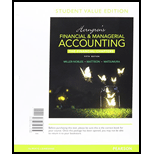
Trading Investments:
Trading investments are the investments in debt or equity securities where the investor holds less than 20% of the voting stock. The investor wishes to sell these investments at a short notice like in a few days, week, or months to generate some profit out of it. They are treated as current assets.
To identify: How the given investment would be classified.
Answer to Problem 1QC
When the investor invests in the debt or equity securities, holding less than 20% of the voting stock of the investee company, in view of selling them in the near future, then such investment is known as a trading investment.
Hence, the correct answer is option b. Trading investment.
Explanation of Solution
Justification for incorrect answers:
Option a. Significant interest investments are the equity securities where an investor holds more than 20%, but less than 50% of the voting stocks. Here, Railway I (investor) will own only 5% of the voting stock of Company P. Hence, option a. is incorrect answer.
Option b. Trading investments are short-term securities where the investor owns less than 20% of the voting stock of the investee company which are bought to sell in the near future to generate profits.
The investment made by Railway I is a trading investment as it represents 5% of voting stocks and investment was made for 3 months.
Option c. Held-to-maturity investment is the investment which is held till their maturity date. Here, Railways I is not planning to hold the investment till maturity, but is planning to hold them for only three months. Hence, option c. is an incorrect answer.
Option d. Controlling interest investments are the equity securities where an investor holds more than 50% of the voting stocks. Here, Railway I will hold only 5% of the voting stock of the investee company. Hence, option d, is an incorrect answer.
Justification for correct answer:
Option b. As the investor company (Railway I) is considering investing in the investee company (Company P) for a short period (three months), and the investment will represent less than 20% of the voting stock (5%) of the investee company, then such investment would be classified as a trading investment.
Hence, option b. is the correct answer.
Want to see more full solutions like this?
Chapter 10 Solutions
Horngren's Financial & Managerial Accounting, The Financial Chapters (Book & Access Card)
- Can you explain the process for solving this financial accounting problem using valid standards?arrow_forwardI need help with this general accounting question using the proper accounting approach.arrow_forwardI am searching for the correct answer to this general accounting problem with proper accounting rules.arrow_forward
- I am searching for the accurate solution to this financial accounting problem with the right approach.arrow_forwardVanessa Trends forecasts sales of $318,000 for the quarter ended December 31. Its gross profit rate is 25% of sales and its September 30 inventory is $74,600. If the December 31 inventory is targeted at $88,400, budgeted purchases for the fourth quarter should be ____. A. $226,000 B. $252,300 C. $225,100 D. $268,900 E. $238,900arrow_forwardPlease provide the accurate answer to this general accounting problem using valid techniques.arrow_forward
 Financial Reporting, Financial Statement Analysis...FinanceISBN:9781285190907Author:James M. Wahlen, Stephen P. Baginski, Mark BradshawPublisher:Cengage Learning
Financial Reporting, Financial Statement Analysis...FinanceISBN:9781285190907Author:James M. Wahlen, Stephen P. Baginski, Mark BradshawPublisher:Cengage Learning Pfin (with Mindtap, 1 Term Printed Access Card) (...FinanceISBN:9780357033609Author:Randall Billingsley, Lawrence J. Gitman, Michael D. JoehnkPublisher:Cengage Learning
Pfin (with Mindtap, 1 Term Printed Access Card) (...FinanceISBN:9780357033609Author:Randall Billingsley, Lawrence J. Gitman, Michael D. JoehnkPublisher:Cengage Learning EBK CONTEMPORARY FINANCIAL MANAGEMENTFinanceISBN:9781337514835Author:MOYERPublisher:CENGAGE LEARNING - CONSIGNMENTCentury 21 Accounting Multicolumn JournalAccountingISBN:9781337679503Author:GilbertsonPublisher:Cengage
EBK CONTEMPORARY FINANCIAL MANAGEMENTFinanceISBN:9781337514835Author:MOYERPublisher:CENGAGE LEARNING - CONSIGNMENTCentury 21 Accounting Multicolumn JournalAccountingISBN:9781337679503Author:GilbertsonPublisher:Cengage Fundamentals Of Financial Management, Concise Edi...FinanceISBN:9781337902571Author:Eugene F. Brigham, Joel F. HoustonPublisher:Cengage Learning
Fundamentals Of Financial Management, Concise Edi...FinanceISBN:9781337902571Author:Eugene F. Brigham, Joel F. HoustonPublisher:Cengage Learning





